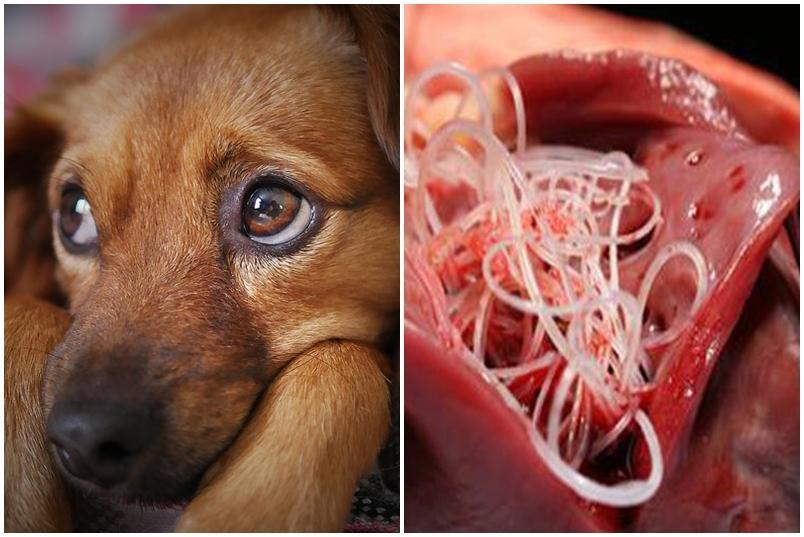Heartworms in dogs- Dirofilariasis, or heartworm illness, is a dangerous and potentially fatal condition. Dirofilaria immitis, a blood-borne parasite, is the cause. In the United States and many other areas of the world, heartworm disease is a dangerous and potentially fatal condition in pets. It is caused by heartworms in dogs, which are foot-long worms that live in the heart, lungs, and blood vessels of infected pets, causing severe lung illness, heart failure, and organ damage.
Mosquitoes spread the disease by carrying heartworm larvae from an infected animal host to a new animal host. After arriving in a new host, the larvae develop into adult worms and dwell in blood arteries that serve the heart and lungs for several months.

The heartworms in dogs disease are not transmitted directly from dog to dog because it requires the mosquito as an intermediary host. As a result, the disease’s spread correlates with mosquito season, which in many regions of the United States can persist all year. In any given area, the number of affected canines and the length of the mosquito season are directly connected to the incidence of heartworms in dogs disease.
The species of mosquitoes, the environment, and the availability of reservoir animals are all factors that influence the prevalence of heartworm infection. When mosquitoes are actively feeding, the risk of infection is greatest. This usually necessitates temperatures above 15°C.
Table of Contents
Where it can be found
Heartworms in dogs are seen all over the world. It used to be restricted to the south and southeast of the United States. The Mississippi River and its tributaries continue to have the highest number of recorded cases, which are still within 150 miles of the Gulf of Mexico and Atlantic Ocean beaches. The disease, however, is expanding and can now be found in most parts of the country, including California, Oregon, and Washington.
In many provinces across Canada, the disease is a problem in areas where mosquitoes thrive, such as along lakes and coasts. The southern Great Lakes region has the highest number of cases in Canada.
Lifecycle of the transmission
In the life cycle of heartworms, the mosquito is crucial. Adult female heartworms infecting a dog, fox, coyote, or wolf create microfilaria, which are microscopic baby worms that circulate in the circulation. When a mosquito bites and eats a blood meal from an infected animal, it picks up these young worms, which develop into “infective stage” larvae over a 10-to-14-day period.
The infective larvae are then deposited on the surface of the animal’s skin and enter the next host through the mosquito’s bite wound when the infected insect bites another dog, cat, or vulnerable wild animal. It takes about 6 months for the larvae to mature into adult heartworms once they have entered a new host.
Symptoms of heartworms in dogs
The symptoms of heartworms in dogs include the following
- A mild chronic cough
- Reluctance to move
- Weariness after moderate activity
- Reduced appetite
- Slimming down
- Pets with heartworm illness may develop heart failure as the condition advances.
- Due to an overabundance of fluid in the abdomen, the appearance of a large belly
- Blockages in the heart’s blood flow
- Difficult breathing
- Gums that are pale
- Death
- Dark bloody or coffee-colored urine
Diagnosis
Heartworm infection can be diagnosed in a variety of ways by your veterinarian. The antigen detection test is the method of choice for confirming suspected heartworms in dogs infection diagnosis. This test is simple to perform and is often regarded as the most accurate test for dogs. However, because this test can only identify adult, female worms, it cannot detect early infections.
This is one of the reasons why your veterinarian will most likely recommend that you get this test done once a year. Echocardiography, blood tests, and chest x-rays are some of the other diagnostic methods available. Your veterinarian will choose tests depending on your history of preventive medication use as well as the dog’s overall health.

The side effect of heartworms in dogs
Microfilariae (immature heartworms). Microfilariae can be found all over the body, but they prefer to stay in the small blood vessels. Microfilariae, which are about the same width as small vessels, may obstruct blood flow in these vessels. The nutrients and oxygen normally delivered by the blood are subsequently denied to the cells supplied by these arteries. The lungs and liver are the primary targets of microfilariae.
Coughing is caused by the destruction of lung tissue. Cirrhosis of the liver develops as a result of liver injury, resulting in jaundice, anemia, and widespread weakness. The kidneys may be impacted as well, allowing toxins to build up in the body.
Heartworms in their adult stages. Adult heartworms infect the heart and main blood arteries leading from it, including the pulmonary artery, causing illness. They also obstruct the heart’s valves from working properly. The blood supply to various organs of the body is diminished when the main blood vessels get clogged, notably blood flow to the lungs, liver, and kidneys. These organs can malfunction as a result of reduced blood flow and oxygen delivery.
The number of mature worms present, their location, the length of time the worms have been in the dog, and the degree of damage to the heart, lungs, liver, and kidneys all influences the indications of heartworm illness. Heartworms can survive for up to five years as adults. Females generate millions of progeny called microfilaria during this period. These microfilariae primarily live in the bloodstream’s tiny channels.

Treatment of heartworms in dogs
Prior to heartworm therapy, dogs with severe heartworm in dogs disease may require antibiotics, pain relievers, special diets, diuretics to eliminate fluid accumulation in the lungs, and/or pharmaceuticals to improve heart function. Even after the heartworms have been removed, some dogs may require ongoing heart failure care. Before heartworm treatment, severely infected dogs may require drugs to stabilize their heart and lung condition.
Both adult and immature heartworms are killed by proper therapy. Existing infections are treated using one of two approved treatment protocols, or methods: a 2-dose protocol or a 3-dose protocol. The drug is injected deep into the muscles of the dog’s back in both circumstances, alternating sides of the back between treatments.
Dead heartworms may cause significant respiratory issues as a result of treatment, especially if dogs are not appropriately confined to prevent an activity after treatment. These issues might appear anywhere from a few days to six weeks after heartworms in dogs -infected dog has been treated. Coughing, spitting up blood, hard or quick breathing, fatigue, lack of appetite, and fever are all indicators of post-treatment problems.
Cage confinement, together with several days of oxygen treatment and medications to manage inflammation and minimize blood clotting, may aid dogs with heartworm treatment problems. Most dogs begin to recover from treatment difficulties within 24 hours if they are properly cared for. Worms in the heart of severely affected dogs can dramatically reduce blood flow.
RECOMMENDED ARTICLES
- What Is Food Allergy In Dogs And Treatment?
- Heartworms in Cats- Causes, Transmission, And Treatment
- Loss Of Appetite In Dogs- Causes, Symptoms And Treatment
- Destructive Behavior In Dogs – 7 Effective Causes, Symptoms And Treatment




